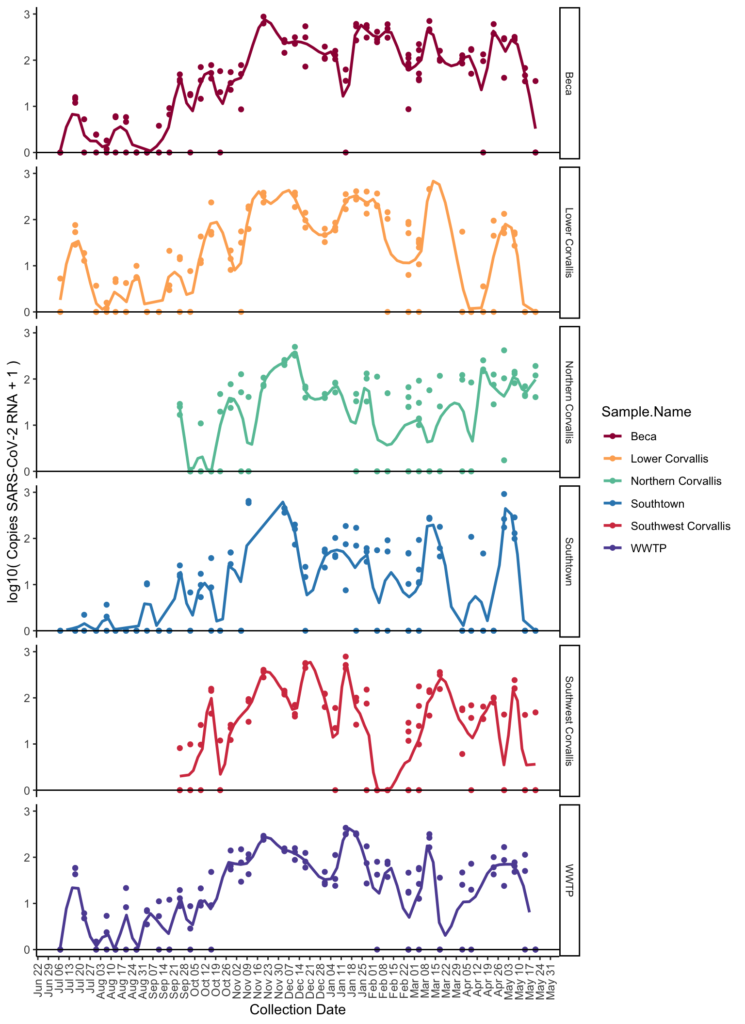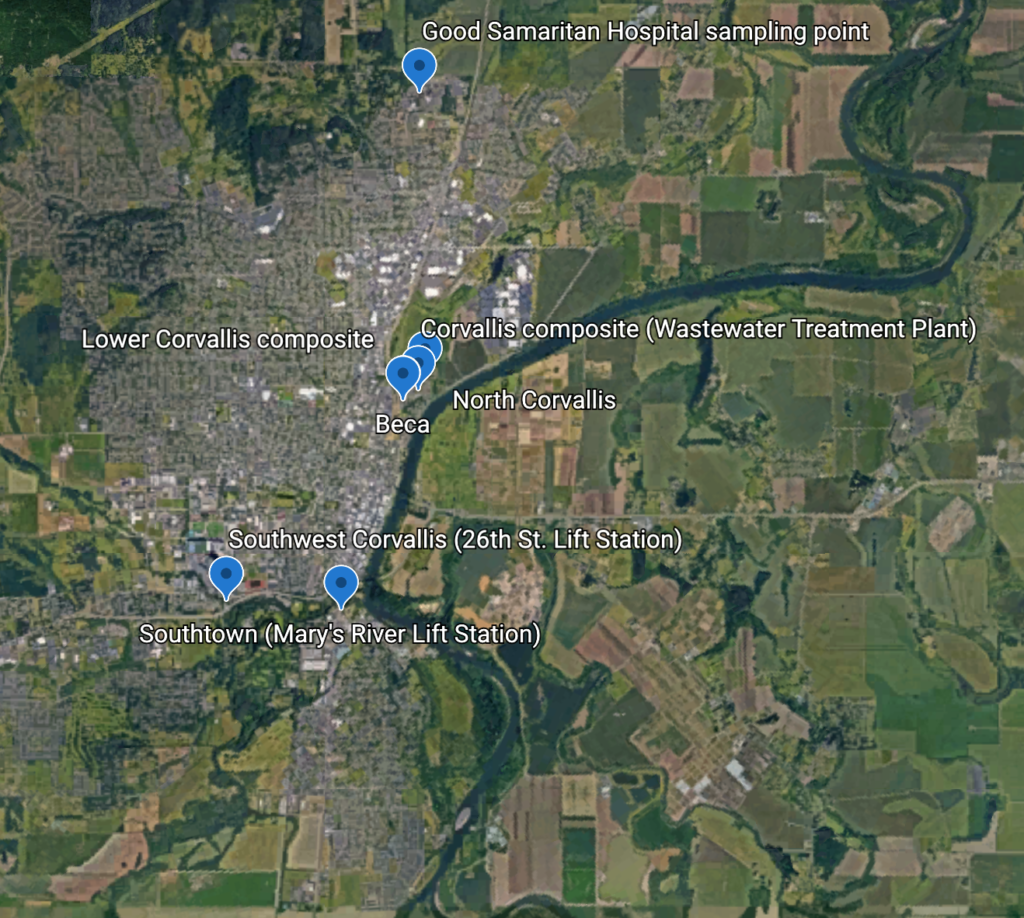Corvallis Wastewater Project
Updated May 25, 2021
We are using wastewater as a COVID-19 surveillance method within the City of Corvallis. This cooperative effort between Oregon State University and the City of Corvallis samples the sewer collection system at specific locations each week. This method allows us to track SARS-CoV-2 detection rates across different areas of the city, identify seasonal trends of detection, and monitor effectiveness of COVID-19 guidelines and restrictions.
Key Findings:
- SARS-CoV-2 RNA has been regularly detected in every sampling site across the city of Corvallis.
- Patterns of SARS-CoV-2 detection differ across the regions within the city.
- SARS-CoV-2 detection patterns, at the city level, are similar to Benton County Health total case loads, which are relatively low comparted to other cities.
How it works:
Infected humans excrete SARS-CoV-2 RNA in their feces (Corman et al. 2016; Leung et al. 2004). This is useful because fecal shedding of SARS-Cov-2 RNA can be detected in asymptomatic as well as symptomatic individuals, and shedding can occur up to 7 weeks after symptom onset (Tang et al. 2020; Wu et al. 2020; Xiao et al. 2020). Wastewater samples can therefore be an effective method for detecting COVID-19 prevelence in the population associated with specific sewer systems drainages. This disease monitoring tool is being used in cities and towns around the world and can be paired with individual-based testing to corroborate results and expand monitoring coverage.
Wastewater is collected at specific points within the sewer system over a 24-hr period each week at 6 locations within Corvallis. We’ve broken up the city into specific districts (Fig. 1, Northern Corvallis, Southtown, Southwest Corvallis, Beca) and composite samples that capture more than one area (Fig. 1, Lower Corvallis, Wastewater Treatment Plant).
Figure 1. Map of sewer network, drainage basins, and sampling coverage in Corvallis
Map of 6 distinct sampling districts: North Corvallis (green) drains 5 sewer basins, Beca (red) drains 1 basin, Southwest Corvallis (pink) drains 4 basins, and Southtown (blue) drains 1 basin. Our composite samples drain multiple sampling basins: Lower Corvallis drains Southtown, Southwest Corvallis, and the OSU/Downtown basins, while the Wastwater Treatment Plan drains every basin in Corvallis.
SARS-CoV-2 in Corvallis Wastewater
Figure 2. SARS-CoV-2 detections within individual sample basins
Each point represents the amount of SARS-CoV-2 RNA in each of three wastewater RT-qPCR sample replicates per week and site presented on a log scale. Unit increase indicates 10 times more RNA. Data points at the zero line (very low risk) indicate replicates with no quantifiable SARS-CoV-2 RNA. Wastewater collection began on 7/18/20 and continues weekly.The Corvallis Wastewater Treatment Plant (WWTP) sample is a composite of all drainage basins, while Lower Corvallis is a composite of the Downtown area, OSU, Southtown, and Southwest Corvallis.
We include smoothed lines representing the trends using a quantity of zero SARS-CoV-2 RNA when sample replicates were not detected. Qualitatively, we consider the RNA concentrations to correspond to the following levels of covid-19 in the wastewater.
Very Low levels = <1 log10 copies, Low = 1-2 log10 copies, Moderate = 2-3 log10copies, High = 3-4 log10 copies, and Very High >4 log10 copies

Corvallis Sewer Collection System- a description
Our sampling design targets specific points along the sewer collection system to capture drainage from distinct neighborhoods or districts. The City of Corvallis Public Works, which manages the Corvallis sewer collection basins and wastewater treatment plant, have the sewer collection system divided into 19 individual drainage basins. The North Corvallis sample contains wastewater drainage from 4 basins (Garfield, Highland, North 9th, and Jackson Creek). The Beca sample includes drainage primarily from the Beca basin. The Southwest Corvallis sample is taken at the Brooklane Lift Station and contains 4 basins: Brooklane, Country Club, Dunawi Creek, and Lower Oak. The Southtown sample covers only one basin (South Corvallis) and is collected at the Mary’s River Lift Station. We also collect from a sewer line draining the Good Samaritan Hospital campus.
We also collect two composite samples that are ‘downstream’ of our other sampling points. The Wastewater Treatment Plant sample is a composite of all 19 basins, and our Lower Corvallis composite sample contains the Southtown, SW Corvallis, and OSU/Downtown basins (Western Blvd, Van Buren, Mary’s River, Jefferson, Jackson, and Fillmore). Three basins, Northeast, Frazier Creek, and Lewisburg) are not directly or indirectly sampled in our project.
Throughout many of these basins, the sanitary and storm water are seperate, draining into distinct lines. The older parts of the city, however, have a combined sanitary and storm drain system. These combined lines are contained within our Lower Corvallis composite sample and, specifically, the Van Buren, Western Blvd, Jefferson, Jackson, and Fillmore basins. As such, dilution during rain events are possible in the lower Corvallis samples. This dilution factor will be determined by metadata on sewage flow rates at lift stations and the treatment plant, and can be detected by reduced concentrations of our RP control gene that would also be diluted by rainwater.
Methodology
Wastewater is collected at each site over a 24-hr period. At the top of each hour, a 250 ml sample is collected into a 10L HDPE bottle. All ISCO 3700 or 6712 model auto-samplers are packed with ice prior to the collection period. After the last sample is collected, the 10 L bottle is vigorously shaken and 500 ml is transfered to a sterile HDPE bottle and placed in a double containment cooler. Auto-samplers and sampling lines are then rinsed with a 20% bleach solution and then rinsed with tap water. After all 7 sample sites have been visited, all samples are brought to the lab at Oregon State University.
We incubate wastewater at 4C overnight in a 240 ml reaction with 20% polyethylene glycol and 0.2 M NaCl. We transfer the wastewater to six 50 ml gasketed centrifuge tubes and centrifuge at 12,000g for 30 mins at 4C. The resulting pellet is resuspended in PBS and nucleic acids are then extracted using the AllPrep PowerViral DNA/RNA kit. We quantify SARS-CoV-2 RNA in 2 uL of template using RT-qPCR with the CDC N1 primer/probe set, which we have found to be superior to the N2 and N3 sets. We use primers and probes for the human RNase P gene as a control that should always be detected in wastewater.
Sampling in Action
Shane Sinclair with the City of Corvallis Public Works, and Tiffany Garcia, Professor with the Department of Fisheries and Wildlife at Oregon State University, set up a sampler at the Good Samaritan sampling site. Photos from Sean Nealon (OSU).
Shane Sinclair with the City of Corvallis Public Works and Tiffany Garcia, Professor with the Deptartment of Fisheries and Wildlife at Oregon State University, set up a sampler at the Mary’s River Lift Station that samples all of Southtown. Photos from Sean Nealon (OSU).
Collection sites
